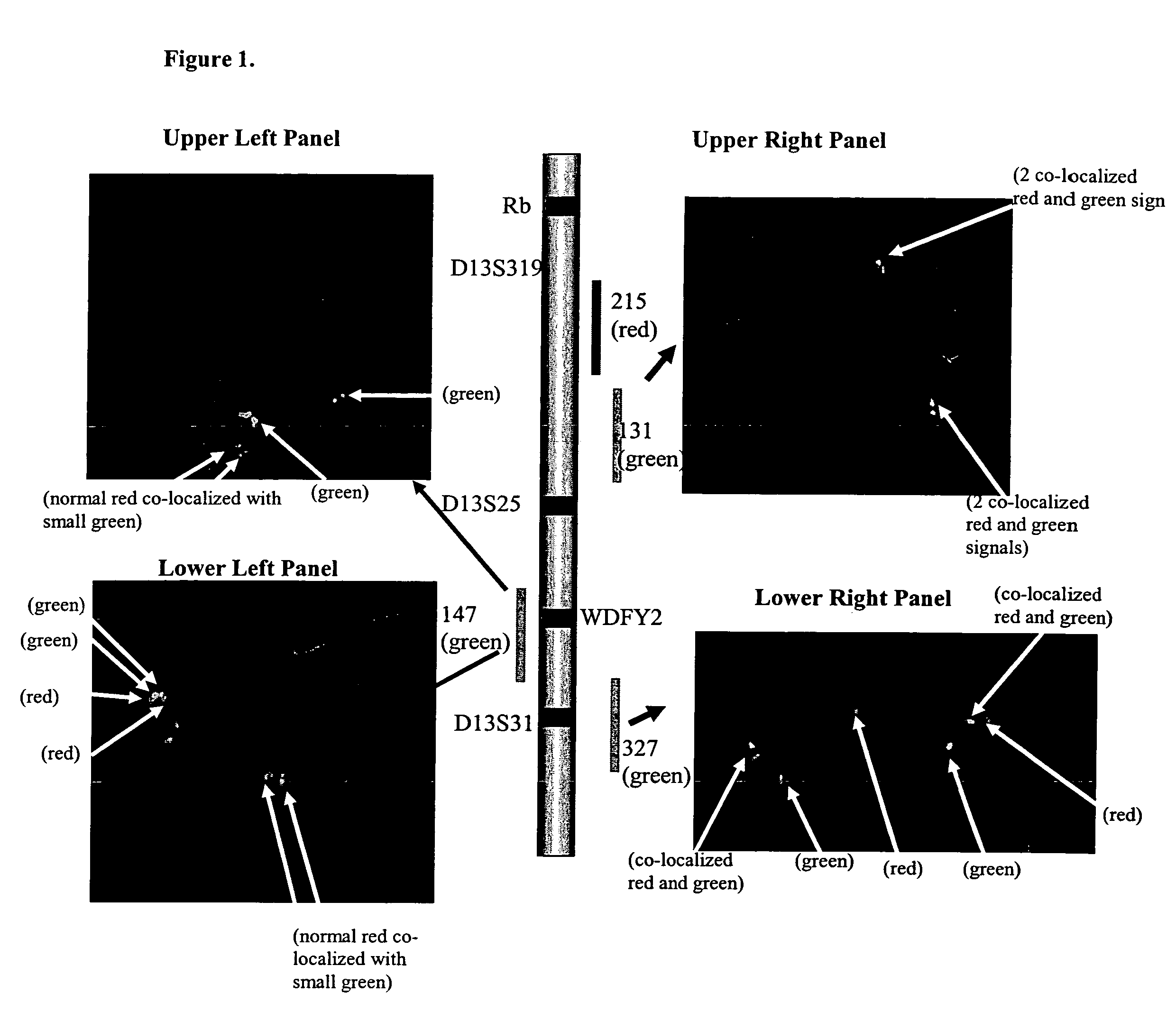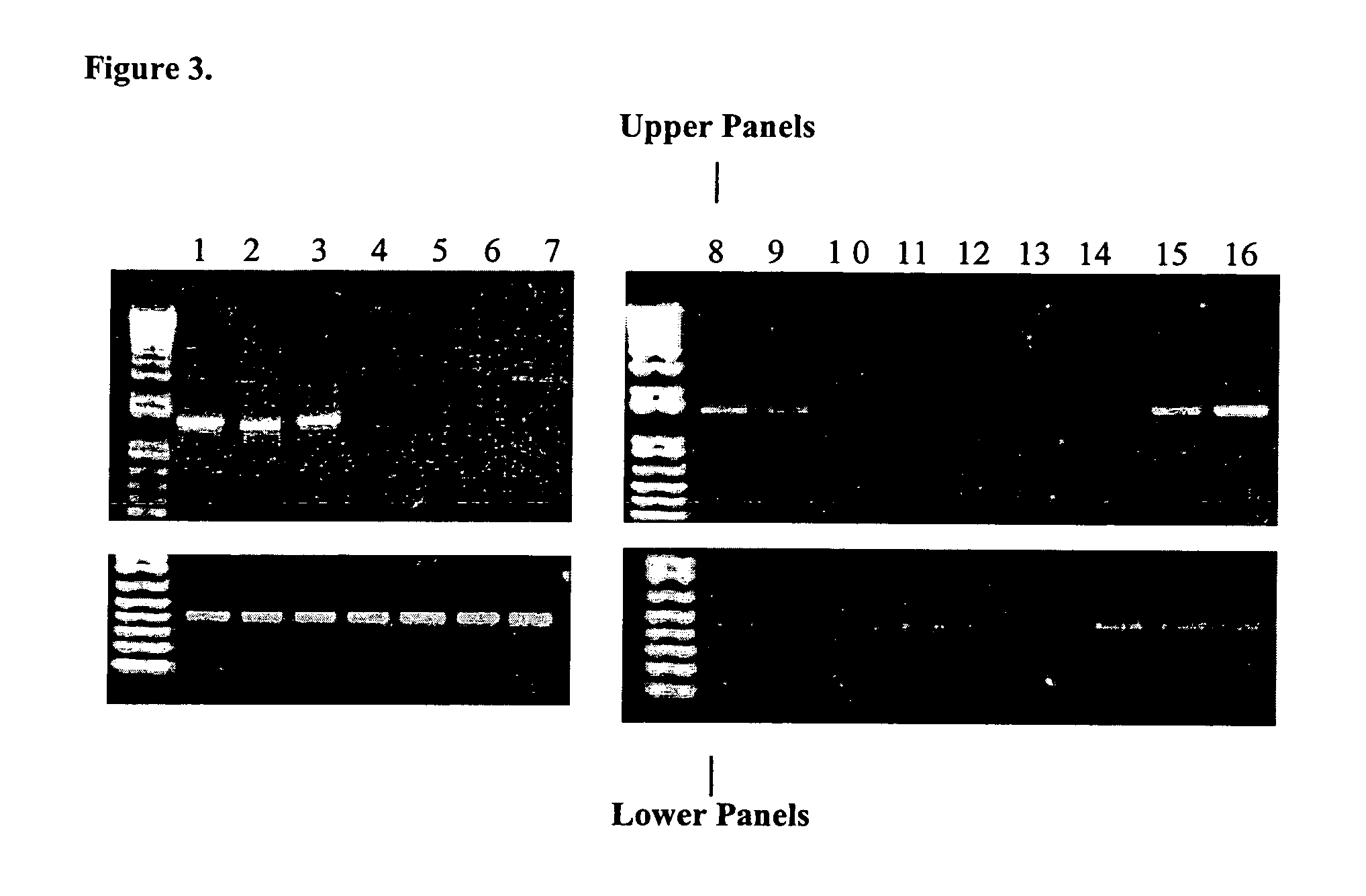Detection of 13q14 chromosomal alterations
a chromosomal alterations and detection method technology, applied in the field of lymphoproliferative diseases, can solve the problems of not being able to demonstrate the consistent involvement of any of the genes located in the deleted region, the current knowledge of the molecular pathogenesis of b-cll is limited, and the detection rate of 13q14 deletions is not 100%
- Summary
- Abstract
- Description
- Claims
- Application Information
AI Technical Summary
Benefits of technology
Problems solved by technology
Method used
Image
Examples
example 1
[0037]The present Example provides an illustration whereby a DNA sequence for use in determining that an individual is likely to have ALL or CLL can be identified.
[0038]In order to identify such a sequence, a FISH chromosomal walking approach on human chromosome 13 was undertaken using RPCI BAC clones RP11-147H23, RP11-215B15 (GenBank accession no. AL136527), RP11-131F1 (AL157761) and RP11-327P2 (AL 162377) also referred to herein as “147”, “215”, “131” and “327,” respectively.
[0039]To prepare the BAC clones for use in FISH assays, the BAC DNAs were extracted from E. coli using a DNA extraction kit (Qiagen). The extracted BAC DNA was then subject to nick translation labeling with fluorochrome-conjugated nucleotides using a commercially available kit (Vysis, Downers Grove, Ill.).
[0040]These clones were utilized in a double color FISH assay. In this approach, the 215 clone was used in combination with each of the three remaining BAC clones in individual FISH assays. The 215 clone is e...
example 2
[0046]This Example demonstrates that the double color FISH assay described in Example 1 is useful for determining that an individual is likely to have ALL.
[0047]A series of bone marrow samples from 9 individuals diagnosed with ALL were analyzed with the RP11-147H23 clone in combination with the RP11-215B13 (clone 215 from Example 1). These probes were hybridized as described and detected as described in Example 1. Eight out of nine samples showed a deletion of one allele, as summarized in Table 1.
[0048]
TABLE 1Pt No 13q abnormality% del (BAC 147)Control Probe1948 del(13)(q12q14)22+1217 del(13)(q12q22)67−1539 del(13)(q14q22)92+2280 del(13)(q13)37−2040 del(13)(q14q32)90+1454 del(13)(q14q22)0+2747 del(13)(q12q22)90−1001 del(13)(q14q21)50−1037 der(9)t(9; 13)(p21; q14)30+(del / split)
[0049]The patients showing (−) for the control probe were interpreted as having a chromosomal deletion that encompassed the region of the chromosome to which the control probe is complementary.
[0050]Therefore, ...
example 3
[0051]This Example demonstrates that the double color FISH assay described in Example 1 is useful for determining that an individual is likely to have CLL.
[0052]To investigate chromosomes from individuals afflicted with CLL, ten CLL cases were randomly selected for FISH analysis. As can be seen in the three panels of FIG. 2, all 10 assays (shown distributed in panels 1-3 of FIG. 2) showed a deleted FISH hybridization pattern as demonstrated in each case by the pair of co-localized red and green signals and the unpaired red signal from a chromosome 13 in which the region to which the 147 clone would normally hybridize is deleted. An additional 25 CLL cases from Roswell Park Cancer Institutes (RPCI) were studied using this technique and 18 / 21 (85%) of these showed a deleted hybridization pattern (data not shown).
[0053]Further, a series of non selected samples were hybridized also analyzed by FISH with the 147 and 215 clones. The results summarized in Table 2 represent the % of cells p...
PUM
| Property | Measurement | Unit |
|---|---|---|
| threshold | aaaaa | aaaaa |
| fluorescence in situ hybridization | aaaaa | aaaaa |
| sizes | aaaaa | aaaaa |
Abstract
Description
Claims
Application Information
 Login to View More
Login to View More - R&D
- Intellectual Property
- Life Sciences
- Materials
- Tech Scout
- Unparalleled Data Quality
- Higher Quality Content
- 60% Fewer Hallucinations
Browse by: Latest US Patents, China's latest patents, Technical Efficacy Thesaurus, Application Domain, Technology Topic, Popular Technical Reports.
© 2025 PatSnap. All rights reserved.Legal|Privacy policy|Modern Slavery Act Transparency Statement|Sitemap|About US| Contact US: help@patsnap.com



